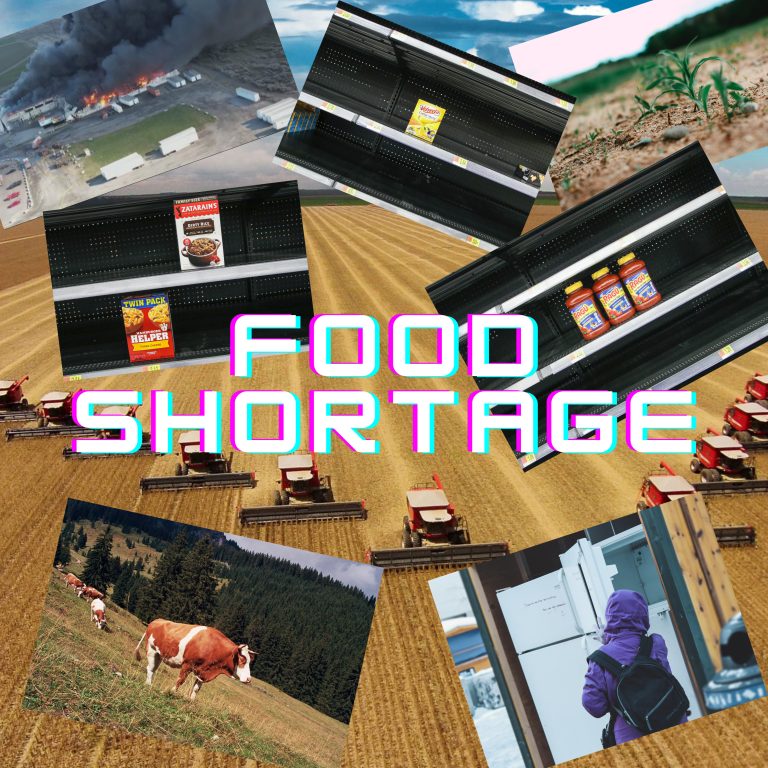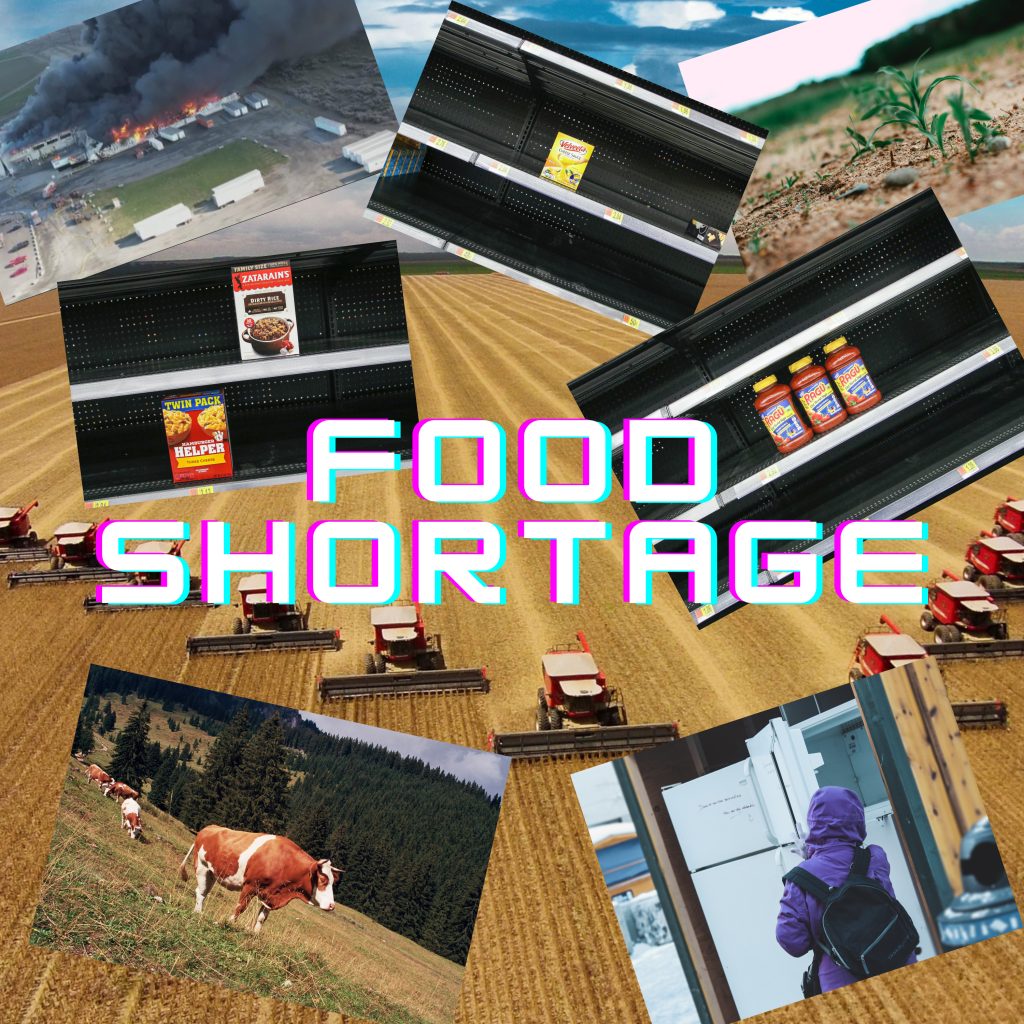
This show will get to the bottom of all those questions you need answers to. Each week, we will cover a topic that has been left unattended in the public square, with unanswered questions surrounding the “official story.” You will be able to determine on this show if the topic has been deemed a “Conspiracy” or a “Conspiracy Theory”.
If you want to support the show, you can become a subscriber and get access to bonus content. Click here to support https://creators.spotify.com/pod/profile/bottomofthat/subscribe
Food Shortages | Covid pandemic causing shortages or is it designed to push for a synthetic agenda?
• The COVID-19 pandemic is causing breaks in our food chain, resulting in shortages of products, like beef and pork, in some stores.
• Scarcity of items has led some people to begin panic-buying products en masse that ended up going bad or spoiling.
• Experts advise that if certain meat items are scarce in your area, now might be the time to try plant-based substitutes to relieve some stress on our strained system and give you peace of mind about your own food security.
Deliberate food shortage conspiracy theory? So what’s the Play?
Food Production Must Double by 2050 to Meet Demand from World’s Growing Population, Innovative Strategies Needed to Combat Hunger, Experts Tell Second Committee | UN Press
Where are our farmers? However, due to climate change, international political tensions, tariff wars, and changing consumer diets, family-run farms have struggled to profit. Over 39% of the income generated by farmers in 2021 will come from tens of billions in government subsidy payments. So, who wants to own a farm?
The ultra-rich, that's who. About 97% of American farms are small and medium-sized family-owned operations. Corporations own the other 3% and rent land or buy many of the crops owned by the 97%. In addition, over 250,000 farms are so-called factory farms owned, rented, or co-opted by corporations. And the rich are now buying up vast swathes of farmland.
Bill Gates becomes the largest farm owner, pessimistic conspiracy theories abound, but Bill Gates, America's largest farmland owner, is born from non-salacious and pragmatic reasons. Gates is just using farmland to make Agri-Tech and financial investments.
Don't forget you can support the show to keep our content flowing by making a decision here”

Food Shortages
Covid pandemic causing shortages or is it designed to push for a synthetic agenda?
From Health-line
• The COVID-19 pandemic is causing breaks in our food chain, resulting in shortages of products, like beef and pork, in some stores.
• Scarcity of items has led some people to begin panic-buying products en masse that ended up going bad or spoiling.
• Experts advise that if certain meat items are scarce in your area, now might be the time to try plant-based substitutes to relieve some stress on our strained system, and give you peace of mind about your own food security

Deliberate food shortage conspiracy theory
So what’s the Play?
Food Production Must Double by 2050 to Meet Demand from World’s Growing Population, Innovative Strategies Needed to Combat Hunger, Experts Tell Second Committee | UN Press
Where’s our farmers?
However, due to climate change, international political tensions, tariff wars and changing consumer diets, family-run farms have struggled to profit. Over 39% of the income generated by farmers in 2021 will come from tens of billions in government subsidy payments.
So, who wants to own a farm?
The ultra-rich, that’s who.
About 97% of American farms are small and medium-sized family-owned operations. Corporations own the other 3% and rent land or buy many of the crops owned by the 97%. In addition, over 250,000 farms are so-called factory farms owned, rented, or co-opted by corporations.
And the rich are now buying up vast swathes of farmland.
Bill Gates becomes the largest farm owner
Pessimistic conspiracy theories abound, but Bill Gates, America’s largest farmland owner, is born from non-salacious and pragmatic reasons. Gates is just using farmland to make Agri-Tech and financial investments.
Owning farmland is one of the most prudent financial investments to make now. Farmland as an investment offers low volatility. In addition, corporations and the rich are investing in farmland to deal with “climate change” and supply products to a hungry world with changing tastes.
New technologies must be developed to give more sustenance to land that we farm to keep it sustainable. Farmlands will only become more automated in the future. The plant-based protein craze will be worth $23.4 billion by 2027.
Agricultural technology advances of the future, or Agri-Tech, will create super productive seeds, sustainable biofuels and super crops.
It seems like Gates is getting ahead of the curve, relative to future Agri-Tech advances profitability, with his farmland investments.
So what is synthetic food?
Green revolution which was started by Dr. Norman Borlaug and Funded by Rockefeller Foundation
The Green Revolution refers to a period of significant agricultural advancements that took place from the mid-20th century, roughly between the 1940s and 1970s. It involved the development and widespread adoption of high-yielding crop varieties, along with improved agricultural practices and technologies. These innovations, including the use of synthetic fertilizers and pesticides, helped increase global food production, particularly in developing countries, and played a crucial role in alleviating hunger
Bill gates had started it again
Bill gates has gained control of the Seed banks. Genetically modifying them to patent the new seeds. Sometimes even mixing the Synthetic food with our normal natural food “unmarked”
He is giving massive subsidies to African farmers to plant his synthetic farms
Iceagefarmers.com
The way to combat is a decentralized food system
Thousands of Cows Die in June of last year due to “ Heat Wave”…
Official Story:
Contacted by Reuters, a spokesperson for the Kansas State University Weather Data Library pointed to data from the Grant Kansas Mesonet weather station as an example (see: mesonet.k-state.edu/ ). At that location in southwest Kansas, the overnight minimum temperatures had been higher thus far in June 2022 than they were in June 2021 and while some daily highs were much higher in 2021, the lows in 2021 were cooler.
Furthermore, “all these elements fell within several days of each other in 2022 compared to spread out in 2021,” they added.
Posts with the claim arguing heat levels are “normal” for this time of the year ( here ) ( here ), fail to consider the above factor.
In a paper published in the Lancet in March, researchers estimated heat stress in animals, described as “one of the major climate change impacts on domesticated livestock,” could lead to annual losses of multiple billions of dollars for the global cattle production industry by the end of the century,( here )
Reuters has reported on the impact of climate change in livestock and global food production ( here )
https://leadstories.com/da3a51175813bc504927c76227da95060b51300d.jpg
2023 Heat Wave
39-day heat wave could last into August after smashing 2,300-plus records
Where were all the Cattle Deaths this year due to heat exposure??
- Decreased Pollinator Population
- Erosion Issues
- Fertilizer Shortage
- Global Supply Chain
- Weather Related
Food Processing Plants
- 04/28/22 Perdue Farms Chesapeake, Va. Authorities say a soybean processing tank caught fire and burned for roughly an hour.
- 04/13/22 Taylor Farms Salinas, Calif. The Salinas Fire Department was initially concerned that a leak could cause an explosion, but later focused its efforts on limiting the public’s possible exposure to the chemical. “There wasn’t, in my mind, an ammonia leak,” says Taylor Farms chairman and CEO, Bruce Taylor. “So what happened was that when the fire started, as part of our emergency protocol, we pumped down the lines that carry the ammonia to the refrigeration system. And whenever you pump down the lines, there’s some residual ammonia in those lines. You can’t get it all out. So that’s what leaked…and people smelled a little bit of that. But it was minor. The concern, of course, was the ammonia tank, which is well protected.” According to Taylor, part of the facility, like the shipping cooler and shipping docks, were spared. But the processing portion of the building is a total loss and will need to be rebuilt.
- 04/18/22 Azure Standard Headquarters, Hermiston, Ore. The fire marshal stated the fire started in a tote of rolled corn which was being temporarily stored in a cooler due to receiving an oversupply at the company’s warehouse. “There are two ways that it may have started,” according to the fire marshal. “Because of the high moisture content of the corn, it could have started smoldering on its own and self-combusted, or the tote or corn dust could have come in close contact to a nearby electrical outlet, shorted the electrical wiring and sparked the tote of corn,” she concludes.
- 03/31/22 Rio Fresh, San Juan, Texas A structure fire significantly damaged a large portion of the facility. The cause of the fire is still unknown.
- 03/24/22 McCrum Potato Plant, Belfast, Maine The fire marshal’s office said the massive fire started in the area of a large fryolator machine, but due to the extensive damage, the exact cause of the fire is undetermined.
- 03/16/22 Nestle, Jonesboro, Ark. Significant damage to a new Hot Pockets production line that was added in 2021 in a $100 million investment.
- 02/22/22 Shearer’s Foods, Hermiston, Ore. The fire at the facility began with an explosion in a boiler fueled by natural gas. Six people were reportedly injured, all of whom were treated at a hospital and released.
Though the direct cause of the explosion is yet unknown, one former Shearer’s Foods employee claims lax safety measures might have contributed to the explosion. Stephen Dean, a former safety manager at Shearer’s from early 2018 to early 2019, spoke to Erick Peterson at the Hermiston Herald. Early in his employment, he says he did some in-depth looks into the facility to identify risks and hazards and found some he deemed as “high risk” and “high consequence.” He was particularly worried about oil fires, he says While he was at the plant, Dean says there were “a bunch of mini-fires,” which were the result of material building up in ovens. In policies and procedures, he says, workers were supposed to rake out the ovens when in a safe state. According to Dean, procedures changed so workers were using compressed air to clean the ovens instead.
“Practices were unsafe, not necessarily because any one person was directing them poorly, but because those practices shifted towards being unsafe,” he says. Dean says once people start doing things one way, they pass on those habits to new workers and behaviors become ingrained. - 02/03/22 Wisconsin River meats, Mauston, Wis. The cause of a fire that destroyed a large portion of the facility remains under investigation.
- 01/20/22 Washington Potato Processing Plant Warden, Wash. The plant was destroyed by a fire believed to have started in a large potato dehydrating drum.
- 01/13/22 Cargill-Nutrena Plant Lecompte, La. While firefighters were in the building fighting the flames, there was an explosion. The cause of the fire and the explosion is still under investigation.
Susan McKelvey, an NFPA spokesperson, noted in an email that national data show the country averaged more than 5,000 fires annually at manufacturing and processing facilities, not just food plants, between 2015 and 2019. She estimated that there have “been approximately 20 fires in U.S. food processing facilities in the first 4 months of 2022, which is not extreme at all and does not signal anything out of the ordinary.”
“The recent inquiries around these fires appear to be a case of people suddenly paying attention to them and being surprised about how often they do occur,” McKelvey said.
‘It’s not unexpected to see fires in these kinds of structures,” said Birgitte Messerschmidt, director of the NFPA Research division. “Fires are not a rare occurrence. We had 490,000 structure fires in 2020 in the United States. We see a lot of fires every year.”
Messerschmidt said food processing plants, like most industrial facilities, are prone to fires. “Food is fuel,” she said. “So as soon as you’re operating with food, you have something that is combustible.” On top of that, Messerschmidt added, you may have heat from cooking, high-pressure systems, combustible dusts, and other risk factors for fires and explosions present at these facilities.
While Messerschmidt hopes the focus on these fires will shift away from the conspiracy theories surrounding them, she said there is still value to examining what went wrong in particular incidents.
These Foods Will Be In Short Supply In 2023
- Corn
- Bread
- Vegetable Oil
- Baby Formula
- Champagne
- Canned Pet Food


